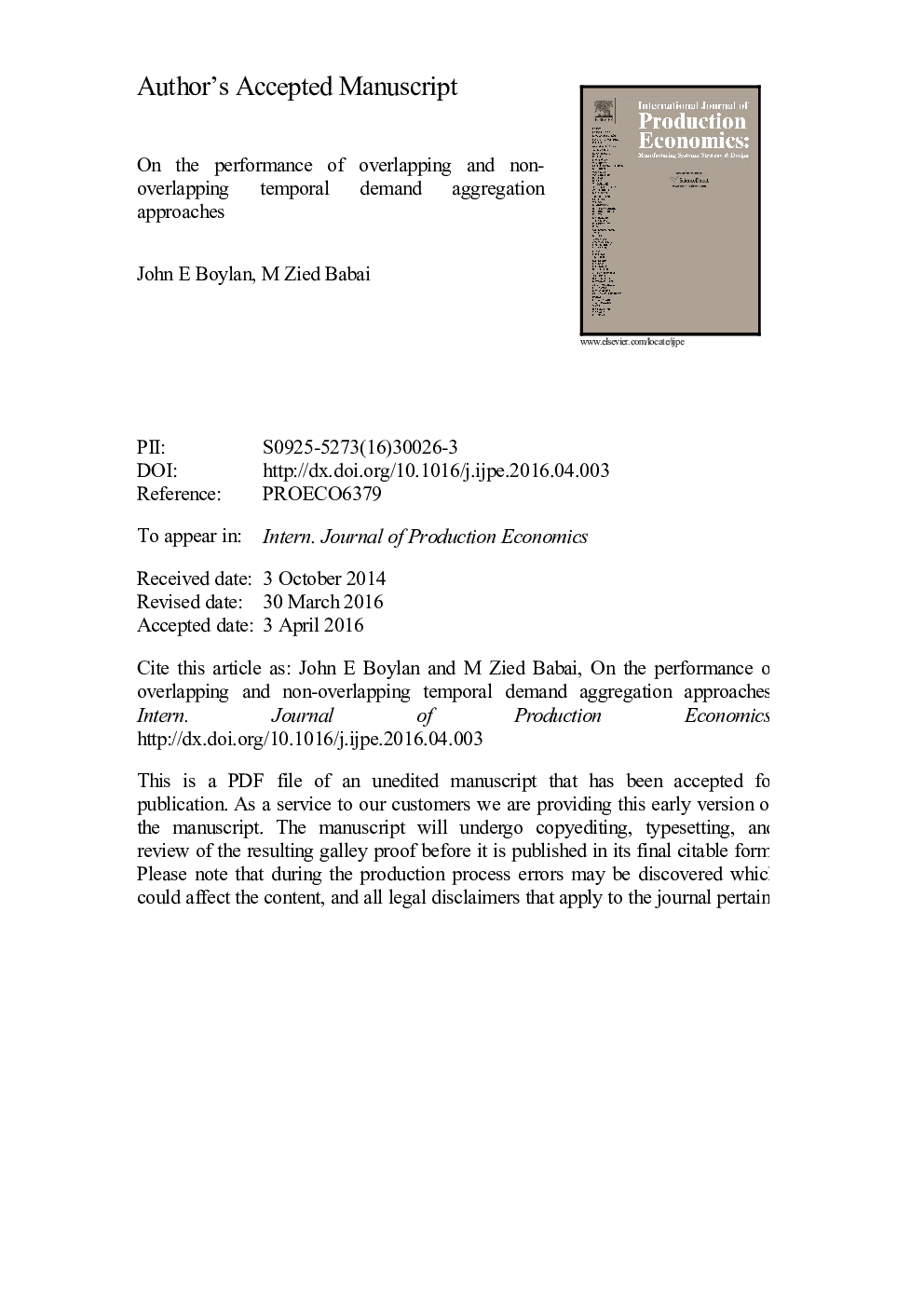| کد مقاله | کد نشریه | سال انتشار | مقاله انگلیسی | نسخه تمام متن |
|---|---|---|---|---|
| 5079155 | 1477526 | 2016 | 33 صفحه PDF | دانلود رایگان |
عنوان انگلیسی مقاله ISI
On the performance of overlapping and non-overlapping temporal demand aggregation approaches
ترجمه فارسی عنوان
بر روی عملکرد تطبیق تقاضای زمانبندی همپوشانی و غیر همپوشانی
دانلود مقاله + سفارش ترجمه
دانلود مقاله ISI انگلیسی
رایگان برای ایرانیان
کلمات کلیدی
تجمع موقتی، با هم تداخل دارند، غیر همپوشانی، تحقیقات تجربی،
ترجمه چکیده
تجمع تقاضای موقت در ادبیات آکادمیک نشان داده شده است که یک رویکرد بصری جذاب و موثر برای مقابله با عدم قطعیت تقاضا برای اقلام سریع حرکت و متناوب حرکت می کند. دو نوع مختلف تجمع زمانی وجود دارد: غیر همپوشانی و همپوشانی. در مورد اول، سری زمانی به سطوح پیوسته غیر همپوشانی زمان تقسیم می شود که طول سطل زمان برابر با سطح تجمع است. مورد دوم شبیه یک روش پنجره حرکتی است که در آن اندازه پنجره برابر با سطح تجمع است. در هر دوره، پنجره یک قدم جلوتر حرکت می کند، بنابراین قدیمی ترین مشاهدات کاهش یافته و جدیدترین شامل می شود. در یک زمینه سهام کنترل، سطح تجمع معمولا به همان زمان مدیریت زمان بستگی دارد. در این مقاله، تحلیل آماری نتایج آماری دو روش را مقایسه می کنیم. با استفاده از تحقیقات عددی و تجربی، ما نشان می دهیم که مگر اینکه تاریخ تقاضا کوتاه باشد، مزیت واضحی از استفاده از بلوک های همپوشانی به جای روش غیر تداخل وجود دارد. همچنین مشخص شده است که حاشیه این مزیت برای زمانهای طولانیتری بیشتر میشود.
موضوعات مرتبط
مهندسی و علوم پایه
سایر رشته های مهندسی
مهندسی صنعتی و تولید
چکیده انگلیسی
Temporal demand aggregation has been shown in the academic literature to be an intuitively appealing and effective approach to deal with demand uncertainty for fast moving and intermittent moving items. There are two different types of temporal aggregation: non-overlapping and overlapping. In the former case, the time series are divided into consecutive non-overlapping buckets of time where the length of the time bucket equals the aggregation level. The latter case is similar to a moving window technique where the window's size is equal to the aggregation level. At each period, the window is moved one step ahead, so the oldest observation is dropped and the newest is included. In a stock-control context, the aggregation level is generally set to equal the lead-time. In this paper, we analytically compare the statistical performance of the two approaches. By means of numerical and empirical investigations, we show that unless the demand history is short, there is a clear advantage of using overlapping blocks instead of the non-overlapping approach. It is also found that the margin of this advantage becomes greater for longer lead-times.
ناشر
Database: Elsevier - ScienceDirect (ساینس دایرکت)
Journal: International Journal of Production Economics - Volume 181, Part A, November 2016, Pages 136-144
Journal: International Journal of Production Economics - Volume 181, Part A, November 2016, Pages 136-144
نویسندگان
John E. Boylan, M. Zied Babai,
